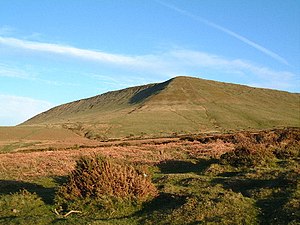Hay Bluff: Difference between revisions
Created page with '{{Infobox hill |name=Hay Bluff |welsh=Penybegwn |county=Brecknockshire |range=Black Mountains |picture=Hay Bluff. Black Mountains Hay-on-Wye - geograph.org.uk - 30553.jpg |pictur…' |
No edit summary |
||
| Line 2: | Line 2: | ||
|name=Hay Bluff | |name=Hay Bluff | ||
|welsh=Penybegwn | |welsh=Penybegwn | ||
|county= | |county 1=Brecknock | ||
|county 2=Hereford | |||
|range=Black Mountains | |range=Black Mountains | ||
|picture=Hay Bluff. Black Mountains Hay-on-Wye - geograph.org.uk - 30553.jpg | |picture=Hay Bluff. Black Mountains Hay-on-Wye - geograph.org.uk - 30553.jpg | ||
|picture caption=Hay Bluff viewed from the north | |picture caption=Hay Bluff viewed from the north | ||
|os grid=SO24433662 | |os grid ref=SO24433662 | ||
|latitude=52.022830 | |||
|longitude=-3.102748 | |||
|height=2,221 feet | |height=2,221 feet | ||
}} | }} | ||
'''Hay Bluff''' is a prominent hill at the northern tip of the [[Black Mountains]]; its summit is in [[Brecknockshire]] but the mountain itself straddles the boundary into [[Herefordshire]]. Its flat summit which overlooks the middle Wye Valley and the book town of [[Hay-on-Wye]] is marked by a triangulation pillar at a height of 2,221 feet. | '''Hay Bluff''' is a prominent hill at the northern tip of the [[Black Mountains]]; its summit is in [[Brecknockshire]] but the mountain itself straddles the boundary into [[Herefordshire]]. Its flat summit which overlooks the middle Wye Valley and the book town of [[Hay-on-Wye]] is marked by a triangulation pillar at a height of 2,221 feet. | ||
==Geology== | ==Geology== | ||
The base and indeed greater part of the hill is formed from mudstones of the St Maughans Formation whilst the upper part is formed from the sandstones and mudstones of the Senni Formation (formerly known as the 'Senni Beds'), both of which are assigned to the Old Red Sandstone laid down during the Devonian period. A number of small quarries have been worked on its slopes in the past, not least for the Ffynnon Limestone, a calcrete which crops out along the | The base and indeed greater part of the hill is formed from mudstones of the St Maughans Formation whilst the upper part is formed from the sandstones and mudstones of the Senni Formation (formerly known as the 'Senni Beds'), both of which are assigned to the Old Red Sandstone laid down during the Devonian period. A number of small quarries have been worked on its slopes in the past, not least for the Ffynnon Limestone, a calcrete which crops out along the north-eastern and north-western flanks of the hill at the base of the Senni Formation. <ref>British Geological Survey 1:50,000 map sheet 214 ''Talgarth'' & accompanying sheet explanation</ref> | ||
==Access== | ==Access== | ||
The [[Offa's Dyke Path]] makes a steep ascent of the hill's northern slopes and then heads | The [[Offa's Dyke Path]] makes a steep ascent of the hill's northern slopes and then heads south-eastwards along the broad ridge of the [[Black Mountain, Black Mountains|Black Mountain]]. A more gentle path to the summit follows the crest of the north-facing scarp, known as Ffynnon y Parc, from the road summit about a mile to the south-west at [[Gospel Pass]]. | ||
The entire hill is designated as open country thus providing walkers with the right to roam. | The entire hill is designated as open country thus providing walkers with the right to roam. | ||
Latest revision as of 08:09, 5 October 2017
| Hay Bluff | |||
| Brecknockshire, Herefordshire | |||
|---|---|---|---|
 Hay Bluff viewed from the north | |||
| Range: | Black Mountains | ||
| Summit: | 2,221 feet SO24433662 52°1’22"N, 3°6’10"W | ||
Hay Bluff is a prominent hill at the northern tip of the Black Mountains; its summit is in Brecknockshire but the mountain itself straddles the boundary into Herefordshire. Its flat summit which overlooks the middle Wye Valley and the book town of Hay-on-Wye is marked by a triangulation pillar at a height of 2,221 feet.
Geology
The base and indeed greater part of the hill is formed from mudstones of the St Maughans Formation whilst the upper part is formed from the sandstones and mudstones of the Senni Formation (formerly known as the 'Senni Beds'), both of which are assigned to the Old Red Sandstone laid down during the Devonian period. A number of small quarries have been worked on its slopes in the past, not least for the Ffynnon Limestone, a calcrete which crops out along the north-eastern and north-western flanks of the hill at the base of the Senni Formation. [1]
Access
The Offa's Dyke Path makes a steep ascent of the hill's northern slopes and then heads south-eastwards along the broad ridge of the Black Mountain. A more gentle path to the summit follows the crest of the north-facing scarp, known as Ffynnon y Parc, from the road summit about a mile to the south-west at Gospel Pass.
The entire hill is designated as open country thus providing walkers with the right to roam.
References
- ↑ British Geological Survey 1:50,000 map sheet 214 Talgarth & accompanying sheet explanation